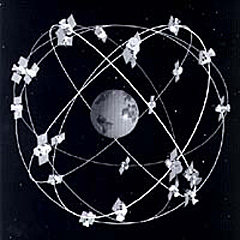Satellite constellation
 From Wikiversity - Reading time: 3 min
From Wikiversity - Reading time: 3 min

A satellite constellation is a group of artificial satellites working together as a system. Unlike a single satellite, a constellation can provide permanent global or near-global coverage, such that at any time everywhere on earth at least one satellite is visible. Satellites are typically placed in sets of complementary orbital planes and connect to globally distributed ground stations. They may also use inter-satellite communication.
Satellite constellations should not be confused with satellite clusters, which are groups of satellites moving very close together in almost identical orbits (see satellite formation flying), satellite programs (such as Landsat), which are generations of satellites launched in succession, and satellite fleets, which are groups of satellites from the same manufacturer or operator that function independently from each other (not as a system).
Learning Task
[edit | edit source]- (Why Groups of Satellite?) Explain why a group of artificial satellites working together as a system can perform a service, that a single satellite could not perform. Refer in your explaination to the following topics:
- Communication[1],
- Navigation,
- Earth Observation,
- (Geostationary Orbits) Explain the advantage of geostationary orbits and the challenges for covering the whole earth for a specific service.
- (Sustainable Development Goals) Explain why observations can help to measure the impact of interventions for accomplishment of Sustainable Development Goals.
- (Satellite Mega Constellation) Search for the numbers of satellites that are launched for e.g. for internet connectivity in remote areas of the world. Does the service break done if single satellites are not operational anymore. What can be done in terms of Risk Management and Risk Literacy for space assest to maintain a specific service on failure.
- (Space Debris) What had to done, if a large number of satellites come to the end of lifetime especially with the large number of satellites in mega constellations[2]. Debris parts and smaller particles with high speed can destroy a satellite or can make at least a service partially unavailable or rescue manouvers of the satellite can reduce the livetime of a satellite due to limited energy resources. How do calculated the economic loss of space debris[3].
Subtopics
[edit | edit source]See also
[edit | edit source]External links
[edit | edit source]Satellite constellation simulation tools:
- AVM Dynamics Satellite Constellation Modeler
- SaVi Satellite Constellation Visualization
- Transfinite Visualyse Professional
More information:
- Internetworking with satellite constellations - a PhD thesis (2001)
- Lloyd's satellite constellations - last updated 20 July 2011
- Examination and analysis of polar low earth orbit constellation-IEEE
References
[edit | edit source]- ↑ Guidotti, A., Vanelli‐Coralli, A., Foggi, T., Colavolpe, G., Caus, M., Bas, J., ... & Modenini, A. (2019). LTE‐based satellite communications in LEO mega‐constellations. International Journal of Satellite Communications and Networking, 37(4), 316-330.
- ↑ Sánchez, A. H., Soares, T., & Wolahan, A. (2017, January). Reliability aspects of mega-constellation satellites and their impact on the space debris environment. In 2017 Annual Reliability and Maintainability Symposium (RAMS) (pp. 1-5). IEEE.
- ↑ Radtke, J., Kebschull, C., & Stoll, E. (2017). Interactions of the space debris environment with mega constellations—Using the example of the OneWeb constellation. Acta Astronautica, 131, 55-68.
Page Information
[edit | edit source]This page was based on the following wikipedia-source page:
 KSF
KSF